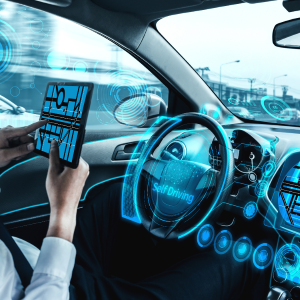Self Driving: Legal Challenges

Blog post by Emilio Kyprianou
Last summer, the UK government released a policy paper stating its goal to have self-driving vehicles operational on public roads by 2025. This plan was developed in response to recommendations from the Law Commission for England and Wales and the Scottish Law Commission. By 2035, the government predicts that 40% of new cars in the UK will have autonomous capabilities and that self-driving vehicles will be used for both passenger and grocery delivery services. However, it is currently illegal to use full self-driving systems on UK roads.
To address this issue, the Law Commissions of England, Wales, and Scotland have proposed the introduction of an Automated Vehicles Act. This act would distinguish between vehicles that can drive themselves and those that have technology to assist the driver. In the event of an accident, the manufacturer or the insurance company would be held accountable for cars that can drive themselves, provided that the self-driving features were active at the time of the crash. The Law Commissions have submitted their report to the UK, Scottish, and Welsh Parliaments.
In order for self-driving vehicles to operate safely on public roads, appropriate regulations, training, and support for human drivers are necessary. These vehicles offer a variety of benefits, including better integration of rural communities, increased accessibility for people with disabilities or the elderly, and safer roads with fewer collisions caused by human error. Self-driving vehicles are not affected by fatigue, distractions, drugs or emotions, allowing them to react quickly and remain focused on safety. Additionally, they can theoretically reduce traffic congestion through communication with other vehicles and road infrastructure.
Therefore, it is crucial to establish new safety standards and testing procedures for self-driving technologies. To this end, the UK government plans to introduce legislation that holds manufacturers accountable for their actions and has committed £100m to achieving safe self-driving vehicles, starting with a phased rollout that allows autonomous driving on motorways.
What is autonomous driving?
SAE International, a global professional association and standards organisation primarily focusing on aerospace, automotive, and commercial vehicle industries, created six levels of driving automation in 2014; ranging from no driving automation (Level 0) to full driving automation (Level 5). Self-driving cars analyse sensor data in real-time to make decisions and employ AI algorithms, specialised cameras, and sensors to navigate and drive.
Since 2015, Tesla CEO Elon Musk has promised to deliver what the company calls "Full Self-Driving" features to its vehicles. However, the rollout has encountered delays and criticism from lawmakers, safety experts, and customers. Some critics also accuse the company of deceiving customers by branding its semi-autonomous driving system as "Full Self-Driving”.
Mercedes-Benz became the first manufacturer worldwide to meet legal requirements for a Level 3 self-driving system, surpassing autonomous pioneer Tesla. In late 2021, the German government granted Mercedes approval for this technology, and the first cars equipped with Level 3 were available for purchase in early 2022. Mercedes has confirmed it is willing to accept responsibility for accidents involving its cars when its self-driving system is engaged, provided it was directly caused by a fault with its technology.
Challenges
As self-driving technology continues to advance, human drivers will increasingly share the road with autonomous vehicles. While this technology promises to reduce human error and make roads safer, it also presents several challenges for us human drivers. One of the main issues is the need for appropriate regulations and training to ensure safe interactions between human drivers and autonomous vehicles. Without these measures, human drivers may not understand how to interact with autonomous vehicles, leading to confusion and potentially dangerous situations on the road.
Another challenge is the potential for human drivers to become complacent or distracted while driving alongside autonomous vehicles. If human drivers assume that the autonomous vehicle will always make the right decision, they may not pay as much attention to the road as they should, increasing the risk of accidents.
Furthermore, there may be issues with communication between human drivers and autonomous vehicles. For example, autonomous vehicles may communicate their intentions to other vehicles on the road, but human drivers may not understand or respond appropriately. Lastly, there is a concern that human drivers may deliberately try to test or disrupt autonomous vehicles, either out of curiosity or malice. This behaviour could lead to dangerous situations on the road and potentially hinder the adoption of autonomous technology.
Conclusion
Overall, the integration of autonomous vehicles onto the road will require careful consideration and further planning to ensure safe interactions with human drivers. It is essential to address these challenges and implement appropriate regulations and training to ensure that autonomous vehicles can operate safely and effectively alongside human drivers. As technological advancements continue at a rapid pace, it is inevitable that we will soon reach a point where level 5 automation becomes a standard feature in most cars. As this transition gathers momentum, it will be important for new legislation to be put in place to address the many challenges that arise during the paradigm shift towards autonomous driving.
References
Government Publications:
Centre for Connected and Autonomous Vehicles, Connected and automated mobility 2025: realising the benefits of self-driving vehicles (CP 719) available at: https://assets.publishing.service.gov.uk/government/uploads/system/uploads/attachment_data/file/1099173/cam-2025-realising-benefits-self-driving-vehicles.pdf accessed 25th Feb 2023.
Law Commission, Automated Vehicles: Summary of joint report (LC Report 404, 2022) available at: https://s3-eu-west-2.amazonaws.com/lawcom-prod-storage-11jsxou24uy7q/uploads/2022/01/AV-Summary-25-01-22-2.pdf accessed 25th Feb 2023.
Articles:
Lee, L (2023) “Mercedes-Benz says it has achieved Level 3 automation, which requires less driver input, surpassing the self-driving capabilities of Tesla and other major US automakers”, Business Insider [online] available at: https://www.businessinsider.com/mercedes-benz-drive-pilot-surpasses-teslas-autonomous-driving-system-level-2023-1?r=US&IR=T accessed 25th Feb 2023.
Wayland, M (2021) “NTSB head criticizes Tesla’s self-driving features, calls them ‘misleading’”, CNBC [online] available at: https://www.lawcom.gov.uk/legal-reforms-to-allow-safe-introduction-of-automated-vehicles-announced/ accessed 25th Feb 2023.

Emilio Kyprianou
My name is Emilio, I am of Greek Cypriot descent and enjoy riding and maintaining motorcycles.
Previously I have studied Psychology with the Open University and was involved in property management before signing up to the OU’s Law program.